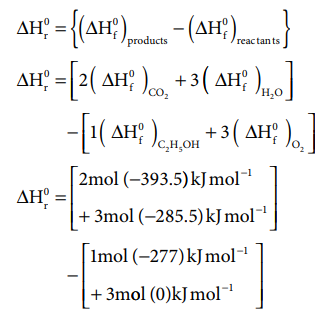Chapter: 11th Chemistry : UNIT 7 : Thermodynamics
Solved Example Problem: Thermochemical Equations
Problem
The standard enthalpies of formation of C2H5OH(l), CO2(g) and H2O(l) are - 277, -393.5 and -285.5 kJ mol-1 respectively.
Calculate the standard enthalpy change for the reaction
C2H5OH(l)+3O2(g) ŌåÆ2CO2(g)+ 3 H2O(l)
The enthalpy of formation of O2(g) in the standard state is Zero, by definition
Solution:
For example, the standard enthalpy change for the combustion of ethanol can be calculated from the standard enthalpies of formation of C2H5OH(l), CO2(g) and H2O(l). The enthalpies of formation are ŌĆō277, ŌĆō 393.5 and ŌĆō285.5 kJ molŌĆō1 respectively.
C3H5OH(l) + 3O2(g) ŌåÆ 2CO2(g) + 3H2O(l)

=[ ŌłÆ787 ŌłÆ 856 . 5] ŌłÆ [ ŌłÆ277]
= - 1643 .5 + 277
ŌłåH0r = ŌłÆ1366 . 5 KJ
Problem
Calculate the value of ŌłåU and ŌłåH on heating 128.0 g of oxygen from 0o C to 1000 C. CV and CP on an average are 21 and 29 J mol-1 K-1. (The difference is 8Jmol-1 K-1 which is approximately equal to R)
Solution.
We know
ŌłåU = n Cv (T2-T1)
ŌłåH = n CP (T2- T1)
Here
n= 128/32 4 moles ;
T2 = 1000
C =373K;
T1 = 00
C = 273K
ŌłåU = n Cv (T2-T1)
ŌłåU = 4 x 21 x (373 - 273)
ŌłåU = 8400 J
ŌłåU = 8.4 kJ
ŌłåH = n Cp (T2- T1)
ŌłåH = 4 ├Ś 29 ├Ś (373- 273)
ŌłåH = 11600 J
ŌłåH = 11.6 kJ
Related Topics